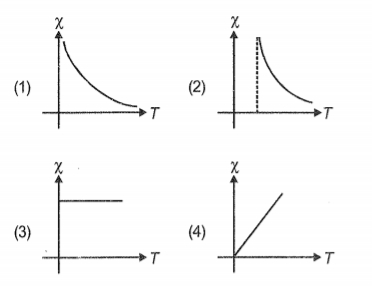The magnetic susceptibility  of a ferromagnetic material varies with temperature, as
of a ferromagnetic material varies with temperature, as

एक लौहचुंबकीय पदार्थ की चुंबकीय प्रवत्ति  ताप के साथ निम्नानुसार परिवर्तित होती है:
ताप के साथ निम्नानुसार परिवर्तित होती है:

 of a ferromagnetic material varies with temperature, as
of a ferromagnetic material varies with temperature, as
 ताप के साथ निम्नानुसार परिवर्तित होती है:
ताप के साथ निम्नानुसार परिवर्तित होती है: 
A: Magnetic dip at the pole is .
R: Magnetic field at the pole is directed horizontally.
1. If both Assertion and Reason are true and the reason is the correct explanation of the assertion.
2. If both Assertion and Reason are true but the reason is not the correct explanation of the assertion.
3. If Assertion is a true statement but Reason is false.
4. If both Assertion and Reason are false statements.
A: ध्रुव पर चुंबकीय नति होता है
R: ध्रुव पर चुंबकीय क्षेत्र क्षैतिज रूप से निर्देशित होता है।
1. यदि अभिकथन और कारण दोनों सत्य होते हैं और इसका कारण अभिकथन की सही व्याख्या होती है।
2. यदि अभिकथन और कारण दोनों सत्य होते हैं लेकिन इसका कारण अभिकथन की सही व्याख्या नहीं होती है।
3. यदि कथन सही कथन होता है, लेकिन कारण गलत होता है।
4. यदि अभिकथन और कारण दोनों गलत कथन होते हैं।
At angle cos-1 to the magnetic meridian, the apparent dip is 60. The true dip at the place is :
1. 30
2. 45
3. 0
4. 60
चुंबकीय याम्योतर से कोण cos-1 पर आभासी नति कोण 60 है। उस स्थान पर वास्तविक नति कोण है:
1. 30
2. 45
3. 0
4. 60
The angle of dip is on a given meridian which is at an angle with the magnetic meridian. If is the angle of dip on another meridian which is perpendicular to the first meridian, then are related as :
1. cot2 = cot2+cot2
2. tan2 = tan2+tan2
3. tan =
4. tan = tan + tan
किसी दिए गए याम्योतर पर नति कोण है जो चुंबकीय याम्योतर के साथ कोण पर है। यदि किसी अन्य याम्योतर पर नति कोण है जो पहले याम्योतर के लंबवत है, तो , और निम्न से संबंधित हैं:
1. cot2 = cot2+cot2
2. tan2 = tan2+tan2
3. tan =
4. tan = tan + tan
If A is the area of the graph of the intensity of magnetisation in ferromagnetic material versus magnetising field intensity, V is the volume of the magnetic sample and n is the frequency of alternating magnetic field, then the rate of hysteresis loss in the substance is
1. A
2. AVn
3.
4.
यदि लौह चुंबकीय पदार्थ में चुंबकन तीव्रता व चुंबकन क्षेत्र की तीव्रता के मध्य ग्राफ का क्षेत्रफल A है, V चुंबकीय नमूने का आयतन है और n प्रत्यावर्ती चुंबकीय क्षेत्र की आवृत्ति है, तब पदार्थ में शैथिल्य हानि की दर ज्ञात कीजिए-
1. A
2. AVn
3.
4.
A magnet is suspended in such a way that it oscillates in the horizontal plane. It makes 20 oscillations per minute at a place where dip angle is 30o and 15 oscillations per minute at a place where dip angle is 60o. The ratio of total earth's magnetic field at the two places is
1. 2.
3. 4:9 4.
एक चुंबक को इस तरह से निलंबित किया जाता है कि यह क्षैतिज तल में दोलन करता है। जिस स्थान पर नति कोण 30o है, वहाँ यह प्रति मिनट 20 दोलन करता है और जिस स्थान पर नति कोण 60o है, वहाँ यह प्रति मिनट 15 दोलन करता है। दोनों स्थानों पर पृथ्वी के कुल चुंबकीय क्षेत्र का अनुपात ज्ञात कीजिए।
1. 2.
3. 4:9 4.
A cylindrical rod magnet has a length of 5 cm and a diameter of 1 cm. It has a uniform magnetisation of 5.30 × 103Amp/m3. What is its magnetic dipole moment ?
(a) (b)
(c) (d)
एक बेलनाकार दण्ड चुंबक की लंबाई 5 cm और व्यास 1 cm है। इसमें 5.30 × 103Amp/m3 का एकसमान चुंबकन है। इसका चुंबकीय द्विध्रुव आघूर्ण कितना है?
(a) (b)
(c) (d)
The magnetic lines of force inside a bar magnet are
1. From south to the north pole
2. From north to the south pole
3. Not present
4. Intersecting each other
दण्ड चुंबक के अंदर चुंबकीय बल रेखाएँ कैसी होती हैं?
1. दक्षिणी ध्रुव से उत्तरी ध्रुव तक
2. उत्तरी ध्रुव से दक्षिणी ध्रुव तक
3. अनुपस्थित
4. एक-दूसरे को प्रतिच्छेदित करती है।
The unit of pole strength is
(1)
(2) Am
(3)
(4)
ध्रुव सामर्थ्य का मात्रक क्या है?
(1)
(2) Am
(3)
(4)
Two identical bar magnets are fixed with their centres at a distance d apart. A stationary charge Q is placed at P in between the gap of the two magnets at a distance D from the centre O as shown in the figure
The force on the charge Q is
1. zero
2. directed along OP
3. directed along PO
4. directed perpendicular to the plane of the paper
दो समान दंड चुंबक d दूरी पर उनके केंद्रों के साथ स्थिर किए गए है। एक स्थिर आवेश Q को दोनों चुबंकों के बीच रिक्त स्थान पर केन्द्र O से D दूरी पर बिंदु P पर आरेख में दर्शाए गए अनुसार स्थित किया गया है।
आवेश Q पर आरोपित बल की गणना कीजिए-
1. शून्य
2. OP के अनुदिश दिष्ट
3. PO के अनुदिश दिष्ट
4. कागज के तल के लंबवत् दिष्ट








